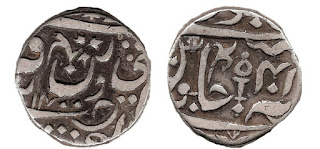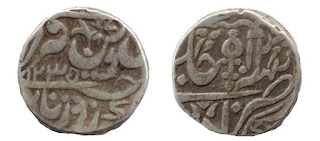Orchha State (also known as Urchha, Ondchha and Tikamgarh), was a kingdom situated in the Bundelkhand region and later a princely state in British India. The state was ruled by the Bundela clan of Rajputs. It was located within what is now the state of Madhya Pradesh.
Orchha, Vikramajit Mahendra , AH 1273.
Orchha State was founded in 1531 by Rudra Pratap Singh, who became its first king. He had a fortress at Garh Kundar and took advantage of the politically unstable environment of the time to make territorial gains. He moved to Orchha on the banks of the river Betwa and established it as his new capital. He died the same year.
Flag
Coat of Arms
Central India Agency Map
Rudra Pratap Singh was succeeded by his son, Bharatichand, who died without leaving a heir in 1554 and was in turn succeeded by his younger brother, Madhukar Shah. Both Madhuri and Madhukar had to deal with attacks, organised under the Afghan Islam Shah Suri (1545-53) and the Mughal emperor Akbar (1556-1605). The situation became so precarious in the 1570s that Madhukar agreed to Orchha becoming a tributary state.
The capture of Orchha by invading Mughal forces
During the rule of Jahangir, his vassal, Vir Singh Deo, was ruler of Orchha area. His reign ended around 1626, and it was during this period that Orchha reached its zenith in both political power and architectural splendour. Jahangir Mahal(1605) and the Sawan Bhadon Mahal are examples.
Vir Singh Deo, 1605-1627
Jahangir Mahal, Orchha Palace
Sawan Bhadon Pillars at Orchha, Tikamgarh
In the early 17th century, Raja Jhujhar Singh rebelled against the Mughals. Shah Jahan placed the raja's brother on the throne in 1641. Orchha was the only Bundela state not entirely subjugated by the Marathas in the 18th century.
Orchha Fort Complex, built by Rudra Pratap Singh in 1501
In 1783, Tikamgarh became the capital of Orchha state. Hamir Singh, who ruled from 1848 to 1874, was elevated to the style of Maharaja in 1865. During his reign, the forces of Datia and Orchha invaded Jhansi intending to divide the Jhansi territory between them. They were, however, defeated by Rani Lakshmibai and her allies in August 1857. Maharaja Pratap Singh born 1854, died 1930, who succeeded the throne in 1874, devoted himself to the development of his state.
Maharaja Pratap Singh, 1900
By 1908, it formed a part of the Bundelkhand Agency and had an area of 2,080 square miles (5,400 square km) and a population of 321,634 as per the 1901 Census. It was the oldest and highest in rank of all the Bundela states, with a 15-gun salute, and its maharajas bore the hereditary title ''First of the Prince of Bundelkhand''.
Vir Singh, Pratap Singh's successor, merged his state with India on 01 January 1950. The district became part of Vindhya Pradesh state, which was merged into the state of Madhya Pradesh in 1956
One Paisa, Shah Alam II, Vikramajit Mahendra, 1797-1824, copper, weight 7.1 gm, Obverse: Inscription ''Shah Alam II''
One Rupee, Vikramajit Mahendra, 1768-1792, silver, weight 10.8 gm, RY 26
One Rupee, Vikramajit Mahendra, 1792-1815, silver, weight 11.6 gm, RY 41One Rupee, Vikramajit Mahendra, 1804-1815, silver, weight 11.6 gm, RY 41
One Rupee, Vikramajit Mahendra, Shah Alam II, AH 1273, silver, weight 10.8 gm, RY 39
















No comments:
Post a Comment
Any inputs or feedback is welcome!